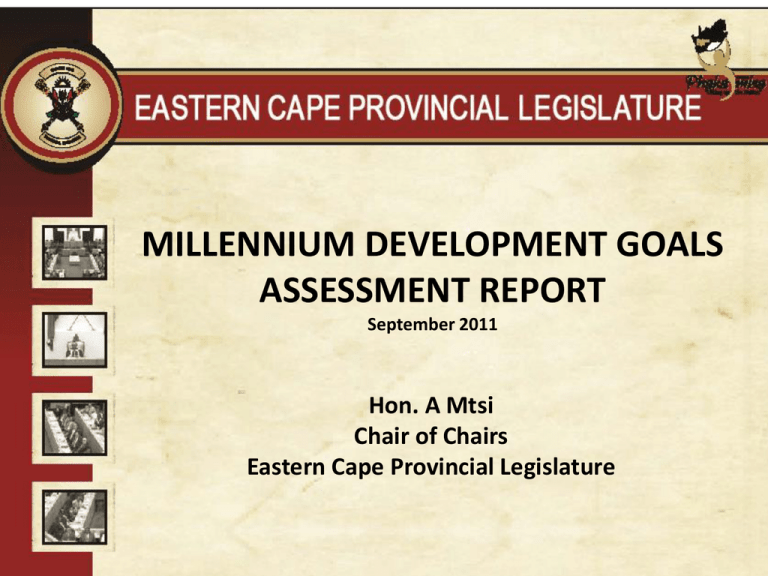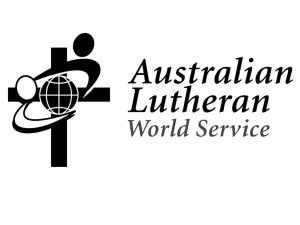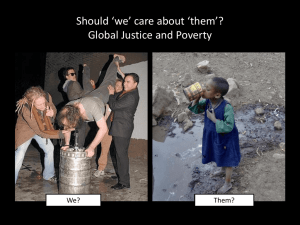MILLENNIUM DEVELOPMENT GOALS ASSESSMENT REPORT
advertisement

MILLENNIUM DEVELOPMENT GOALS ASSESSMENT REPORT September 2011 Hon. A Mtsi Chair of Chairs Eastern Cape Provincial Legislature Overview • • • • • Introduction MDG Assessment Legislature Role in Monitoring Progress Challenges Confronted Conclusion Introduction • MDGs – measurable targets with specific timeframes for collaborative and strategic commitment of resources towards improvement of socio-economic lives of people • Coordinate and streamline development policies between countries • Incorporated into broad planning framework of individual countries • Securing access to basic and socio-economic rights of citizens – e.g. health, education, sanitation, shelter, clean water, safety and security • Important: particularly for African context, to create conducive socio-political environment MDG ASSESSMENT:EASTERN CAPE • Departments have participated in ensuring MDGs are realised. • Challenges have been highlighted which states the difficulty in achieving some of the planned projects. • MDG Goals 1 to 7 are outlined as follows: Goal 1 : ERADICATE EXTREME POVERTY & HUNGER PROGRAMMES/ PROJECTS 1. Social Development • 55 women cooperatives aimed at combating poverty and promoting income generation ventures benefiting 825 households are funded • Household food production initiatives targeting 2275 poor households are established to address their immediate need of hunger. • 500 poor households who are social grant beneficiaries will be linked to sustainable livelihoods and income generation initiatives towards self reliance in this financial year. • Funded projects are trained and mentored on issues of governance and financial management • Funding of 25 Youth entrepreneurship development initiatives Goal 1 : ERADICATE EXTREME POVERTY & HUNGER •341 Masupa-Tsela Youth Pioneers appointed as Auxiliary Community Development Practitioners (ACDP) on a permanent basis. •1000 out of school and unemployed youth appointed as ACDPs Poverty Coordination •The Department is mandated to coordinate and integrate anti-poverty •programmes in all government departments and social partners. War on Poverty programme was first piloted at Lubala and then extended to the 11 identified poorest municipalities. •A programme of action was developed with rural Development and Agrarian •Reform. The programme includes profiling and integrated delivery of services in war on poverty areas as well as a comprehensive rural development programme. Goal 1 : ERADICATE EXTREME POVERTY & HUNGER 2. Health • Key strategic activities of promoting growth monitoring practices to communities and at primary healthcare facilities; in conjunction with the Department of Agriculture ensure that 300 clinics and 30 hospitals have food gardens; 20 cooperatives are developed to improve socio-economic status of their local communities; and facilitate community empowerment and awareness on health-related issues. Goal 1 : ERADICATE EXTREME POVERTY & HUNGER 3. • • • Economic Development Participate in and contribute to programmes that address service delivery backlogs. Working in collaboration with the Departments of Roads and Public Works, attention is paid to identifying mechanisms and opportunities to connect rural villages to towns and cities through a functional road network so as to increase access to economic activities and opportunities. The department’s existing co-operatives programme will be intensified to assist in organising communities to identify, create and exploit local economic opportunities. The Department hopes that this will assist in mitigating the ravaging effects of poverty. Together with its public entities and other departments, the Department aims to assist rural entrepreneurs to participate in the mainstream economy through the provision of skills, opportunities and logistics. Goal 1 : ERADICATE EXTREME POVERTY & HUNGER 4. • • • • • • Roads and Public Works In respect of Expanded Public Works Programme (EPWP), a target of 68 591 work opportunities created by the end of 2010/11 financial year was surpassed as the Province registered 82 696 work opportunities as at the end of December 2010. The total target for EPWP work opportunities to be created by all EPWP sectors and public bodies has increased to 94 504. 02 August 2011 saw the launch of Amathuba (Work Opportunities) Portal which is an interactive database of the unemployed in the Province. This intervention will also assist in matching available skills with those required by contractors in a given locality. The Accelerated Professional Trade Competency Development Programme (APTCoD) Programme will contract 450 trainee artisans by the end of the financial year. This will be complemented by the additional 500 young people to be engaged in the NYS Programme. 400 emerging contractors will be upgraded to higher levels of the Construction Industry Development Board (CIDB) registration. The Household Contractor Programme will recruit an additional 6000 persons, taking the total number to 28 000 across the Province Goal 1 : ERADICATE EXTREME POVERTY & HUNGER 5. Transport 4,588 work opportunities during 2011/12 will be created under EPWP principles and guidelines in the following areas: • Road Ranger project in all six Districts to chase away stray animals on the road; 150 Road Rangers will be employed during 2011/12 financial year. • Employment contracts for 601 Road Rangers have been verified and renewed. • Employment of 40 people for maintenance of Bhisho and Mthatha Airports respectively; • Employment of people for construction of Pedestrian walkways (85), bicycle pathways(60) and parking bays for non-motorised transport; • Employment of people for construction and maintenance of public resting places along the national roads. • 126 training interventions conducted for beneficiaries, Road Rangers, District Transport Forums and Junior Traffic Training Centre (JTTC) – Already 42 Transport Forums have been trained. Goal 1 : ERADICATE EXTREME POVERTY & HUNGER 6. • • Sports, Arts and Culture In the Grahamstown National Arts Festival different artists are given an opportunity to perform and thus get exposure and consequently income. In the same event 11 craft groups were identified as participants in the South African Hand-made collection hosted by DTI, which further exposed them to international markets. Quality and standard of craft products has proven to be a challenge in the province and this has negatively affected sales. One of the important elements was the establishment of 3 cultural hubs in the province to further guide and market cultural practitioners. 7. Education • The ECD programme which is a key contributor to the Expanded Public Works Programme had been conceived to, among others, create jobs for women in disadvantaged communities while ensuring that the children get a solid foundation in preparation for subsequent schooling. GOAL 2: ACHIEVE UNIVERSAL PRIMARY EDUCATION 1. Education The Department is experiencing some challenges in programme implementation • The Back to School Campaign that aims at mobilising out-of-school children. • The 2009 Mid-Year Estimates from Statistics South Africa indicate that there are approximately 1 497 739 children in the province of which 1 341 303 are in the system. This translates to 89, 5% of children between the ages of 7 and 15 attending school. The challenge is effective and efficient implementation of the plans to mobilise out-of-school children and to retain them in the system. Challenge is effective and efficient implementation of the plans to mobilise out-ofschool children and to retain them in the system. • The SNP aimed at promoting access to and attendance of school for those marginalised through abject poverty • In spite of systemic and management problems that tend to hinder proper application of this programme, the Department has made some noteworthy strides. According to the Department, in 2010/11, 1 480 907 learners benefitted from the SNP. Challenges include (i) provisioning of mobile kitchens, (ii) late and non-payment of service providers, (iii) alleged collusion of officials in defrauding the Department of funds meant for economic empowerment of poor women, and, (iv) poor management and control of the programme. Goal 2 : ACHIEVE UNIVERSAL PRIMARY EDUCATION 1. Education • Improving access of 6-year old children to Grade R. The idea is to ensure that more pre-school children are adequately prepared, both socially and cognitively, for the first grade of schooling. • Progress : According to the Education Management Information System (EMIS) of the Department, the 2009 enrolment for Grade R was 154 514, while the average enrolment for Grades 1-3 was 190 863. This represents an 81% performance rate. • Currently, the expansion of ECD provision has resulted in the number of Grade R learners increasing to 174 723 learners thus exceeding the target of 159 375. 14% of ECD practitioners had at least a Level 4 qualification in 2009. • The Department aimed at achieving 26% by end of 2010. The challenges: (i) lack of appropriately and adequately resourced centres and the shortage of appropriately trained teachers hinder effective implementation (ii) the anomaly of an increased Grade R enrolment and a decreased Grade 1 enrolment, and, (iii) the Grade 1 Repetition Rate which is still one of the highest in the General Education and Training (GET) band, (iv) lack of access to quality Grade R programmes. Goal 2 : ACHIEVE UNIVERSAL PRIMARY EDUCATION 1. Education • The adoption of the no-fee and fee exemption school policies is an endeavour by the Department to support learners from poorer backgrounds to access education opportunities. Progress : Currently 81.7% of schools benefit from the No-Fee School and School Fee Exemption policies. The challenges are (i) Eradicating the huge socio-economic barriers to education and ensuring all children have an equal opportunity to schooling.; (ii) low systems capacity, (iii) staff shortages at district level; (iv) lack of administrative capacity in Section 21 schools – poorer schools often cannot properly utilise their full allocation; and, (v) continuous school quintile contestations by communities. Goal 2 : ACHIEVE UNIVERSAL PRIMARY EDUCATION 1. Education • The School Infrastructure Recovery Plan aims at providing suitable school infrastructure by eradicating inappropriate and mud structures in the province. Progress : A series of interventions has been implemented to respond to the complex crisis of infrastructural backlogs, and these include: the ASIDI Programme in conjunction with the Department of Public Works; the National Treasury commitment of R6.36 billion to eradicate these structures, and the Department’s own budgetary arrangements that include private donors. Challenges The extent of challenges confronting these efforts are exacerbated by: (i) the sheer number of these inappropriate and/or mud structures, (ii) the backlogs, (iii) the lack of capacity to manage processes related to this problem, (iv) alleged fraudulent and corrupt practices, ( (v) ‘tenderpreneuring’, (vi) poor financial management, planning, control, and monitoring, and, (vii) governance, management, and leadership tensions and conflicts. Goal 2 : ACHIEVE UNIVERSAL PRIMARY EDUCATION 2. Safety and Security • • • • The Department started to implement the Safer Schools Programme in 2008/09 financial year. The key elements of the programme are to establish School Safety Committees and formulate School Safety Plans. In most instances the targets have not been met. Where the School Safety Committees have been established, they are not functional. The School Safety Plans have not been formulated for the schools in the programme. One of the challenges of this programme has been the lack of co-operation between the Department of Safety and Liaison and the Department of Education However, the South African Police Services has conducted search and seizures in most of the schools within this programme. GOAL 3: PROMOTE GENDER EQUALITY AND EMPOWER WOMEN 1. Education • The ECD programme which is a key contributor to the Expanded Public Works Programme had been conceived to, among others, create jobs for women in disadvantaged communities while ensuring that the children get a solid foundation in preparation for subsequent schooling. Progress and challenges: (i) Monitoring of this programme is not as effective as required (ii) Other social needs cluster departments like Health and Social Development, do not adequately assist in offering relevant services to this programme, and, (iii) the impact on poverty alleviation among women is not properly monitored and measured GOAL 3: PROMOTE GENDER EQUALITY AND EMPOWER WOMEN 2. Safety and Security • The Crime Awareness Campaigns are held in communities to teach, inform and discourage the commission of crimes against women and children. In most instances the targets have been met by the Department. • The main challenge confronting this programme is to gauge whether it is making the necessary impact on communities and the levels of such impact. GOAL 4: REDUCE CHILD MORTALITY 1. Health • • • • • • • • The Department identifies a number of annual indicators related/responding to infant and child mortality targets. These include, inter alia: Immunisation coverage for under 1 year-old (EC = 90.6% measured against a national average of 95.5% as at 2009/2010) – the 2011/2012 target is 92%; Vitamin A coverage for 12 to 59 month-year olds (EC = 93.1% measured against a national average of 36.6% as at 2009/2010) the 2011/2012 target is 67%(page 140 APP); Measles first dose under 1 year coverage (EC = 93.9% measured against a national average of 98.8% as at 2009/2010) – the 2011/2012 target is 95%; Pneumococcal Vaccine (PCV) 3rd dose coverage (EC = 38.5% measured against a national average of 23.1% as at 2009/2010) - the 2011/2012 target is 60%; Rota Virus 2nd dose coverage (EC = 35.2% measured against a national average of 34.7% as at 2009/2010) – the 2011/2012 target is 60%; Babies testing PCR positive six weeks after birth as a proportion of babies tested at six weeks (EC = 9.7% measured against a national average of 11% as at 2009/2010) – the 2011/2012 target is 8%; and Facilities equipped with 60% health professionals trained in IMCI targeted at 70 out of a total 580 facilities targeted to be implementing IMCI. GOAL 5: IMPROVE MATERNAL HEALTH 1. Health • According to the Department, the number of women dying due to pregnancy related conditions (maternal deaths) had been increasing over the years (Figure 10). • A 15% decrease was observed in number of maternal deaths reported during 2010. • A total of 229 maternal deaths were reported against 269 reported in 2009; this translates to a facility-based maternal mortality ratio of 188 per 100,000 live births. GOAL 6: COMBAT HIV/AIDS, MALARIA AND OTHER DISEASES 1. Health TB • The TB programme has for the first time achieved and exceeded the set target for the TB cure rate of 65%; the latest cure rate in the EC Province achieved during 2010 under review was 66%. • Five out of seven districts achieved 70% cure rate and above, with Chris Hani District having the highest rate of 76.2%. With this highly promising and motivating performance coupled with the provision of adequate resources and strong political support, the World Health Organization (WHO) recommendation of achieving an 85% target to overcome the burden of TB in the Province could be realized. HIV and AIDS • The percentage of pregnant women infected with HIV in the Eastern Cape Province had been increasing over the years and reached a peak at 29.1% in 2006. The prevalence trend has reached a plateau with the latest prevalence of 28.1%. The Nelson Mandela Metro had the highest prevalence of 30.7% followed by the OR Tambo district with 29.8%. • In spite of this performance, critical challenges remain. These relate to the underexpenditure of HIV/Aids allocations, lack of effective ventilation protocols and poor infrastructure, particularly in TB hospitals, and infrastructure backlogs in terms of upgrades, revitalisation, etc. Goal 7: ENSURE ENVIRONMENTAL SUSTAINABILITY 1. Human Settlements • Nelson Mandela Bay Municipality – Zanemvula project – Progress to date include installation of solar energy to a thousand houses. A community capacity building programme in partnership with the Sustainability Institute of the University Stellenbosch has commenced. • Ndlambe –Thornhill project – 509 housing units have been completed and handed over to rightful beneficiaries. In addition, energy efficient external windows achieving a good daylight factor have been installed. The Ndlambe -Thornhill mixed-mode development puts emphasis on low and middle income integration through significant Private Sector investment in this project. • Mbhashe – Elliotdale project – The Development Bank of Southern Africa has been appointed as an Implementing Agent to construct 1000 housing units. Government`s Breaking New Ground (BNG) and the Development Bank of Southern Africa (DBSA) Sustainable Development respective programmes have been merged to model a Rural green building housing concept for South Africa in this area. Goal 7: ENSURE ENVIRONMENTAL SUSTAINABILITY 1. Human Settlements • KSD – Ngangelizwe project – Planning for 200 units is at an advanced stage. The establishment of an Innovation Hub which promotes a range of alternative construction technologies is apace. A community capacity building programme in partnership with the Sustainability Institute of the University Stellenbosch has commenced. • BCM – Duncan Village – This project has been escalated to a Presidential status project, with the National Department of Human Settlements and the Development Bank of Southern Africa providing programme and project management support Goal 7: ENSURE ENVIRONMENTAL SUSTAINABILITY 1. • • • • • Local Government and Traditional Affairs The department monitors backlogs eradication on a quarterly basis. Sector departments provide data on a quarterly basis to DLGTA, with DWA responsible for Water, DHS for Sanitation, DEDEA for Refuse removal and DoE (ESKOM) for Electricity. DLGTA is responsible for consolidation of the 5 Year Local Government Strategic Agenda (5YLGSA) which is escalated to DCOG for reporting to Cabinet Legkotla. The challenge with this programme is the authentication of the data – whether it is credible or not, due to lack of monitoring systems at provincial and municipal level, leading to fluctuation of data. This situation was evident with the smallest programme of Bucket Eradication Programme (BEP), where there were conflicting data from various sectors (DWA, DLGTA, municipalities, NGOs, etc). Although most municipalities did report on BEP (in the Formal Settlements) that the target for Dec 2007 was met, there are still very few WSA (Water Services Authorities); municipalities (Chris Hani DM, Amathole DM and Makana LM) that did not meet the target. Goal 7: ENSURE ENVIRONMENTAL SUSTAINABILITY 1. Oversight • As part of oversight, the following activities are embarked on by Portfolio Committees to assess progress and socio-economic impact of government programmes and projects: – – – – – – Scheduled oversight visits; Impromptu visits (particularly visits to schools at the beginning of each financial year); Focused (re-active) interventions as when necessary; Budget analysis and performance monitoring through in-year monitoring (quarterly and annual reports); Expenditure tracking through six-monthly Financial Oversight processes; Monitoring of implementation of House Resolutions • All these processes culminate in reports – with findings and recommendations – which are tabled in the House, and referred to Departments for implementation. • The Legislature, through the Committees’ technical support staff, track this implementation and holds government Departments to account for nonimplementation. THE ROLE OF THE EPCL IN ASSESSING IMPLEMENTATION OF MDGs 2. Public Participation • The Legislature encourages public participation in policy and law-making processes through the following means: • Public hearings; • Public education and participation through sectoral parliaments (institutionalised days) 3. Law-Making • The law-making processes of the Legislature are largely driven by the introduction of new and amendment Bills. • The Legislature, in turn, facilitates publicity and public hearings on specific pieces of legislation before submitting negotiating and final mandates. CHALLENGES Common challenges experienced by Portfolio Committees are : • Poor coordination, and monitoring and evaluation of projects by Departments. • Lack of human capital and skills/expertise to effectively and efficiently implement Departmental projects. Quality of information provided by government departments does not allow for Portfolio Committees to make a meaningful assessment of progress made in implementation of MDGs and the socio-economic impact thereof; The tight schedule of the Legislature does not allow for a specific and rigorous process of overseeing monitoring and evaluation (M&E) mechanisms of Departments and verifying progress made with respect to MDGs; Recurrent findings and recommendations/House Resolutions that are not implemented by Departments and no effective measure to enforce compliance; • • • Conclusion ECPL, with its mandate to conduct vigorous oversight in the Eastern Cape, is committed to guarantee all Departments carry their mandate through projects and programmes effectively to ensure better life for the people. THANK YOU








